Tarek Ahmed. Reservoir engineering handbook
Подождите немного. Документ загружается.


(e.g., comparing flow potential of different wells in the field). The AOF
is then calculated by:
AOF = J p
–
r
• The slope of the straight line equals the reciprocal of the productivity
index.
Example 7-1
A productivity test was conducted on a well. The test results indicate that
the well is capable of producing at a stabilized flow rate of 110 STB/day
and a bottom-hole flowing pressure of 900 psi. After shutting the well for
24 hours, the bottom-hole pressure reached a static value of 1300 psi.
Calculate:
• Productivity index
• AOF
• Oil flow rate at a bottom-hole flowing pressure of 600 psi
• Wellbore flowing pressure required to produce 250 STB/day
Solution
a. Calculate J from Equation 7-1:
b. Determine the AOF from:
AOF = J (p
–
r
- 0)
AOF = 0.275 (1300 - 0 ) = 375.5 STB/day
c. Solve for the oil-flow rate by applying Equation 7-1:
Q
o
= 0.275 (1300 - 600) = 192.5 STB/day
d. Solve for p
wf
by using Equation 7-7:
p = 1300 250 = 390.9 psi
wf
-
Ê
Ë
ˆ
¯
1
0 275.
J STB psi=
-
=
110
1300 900
0 275./
478 Reservoir Engineering Handbook
Reservoir Eng Hndbk Ch 07 2001-10-24 16:49 Page 478
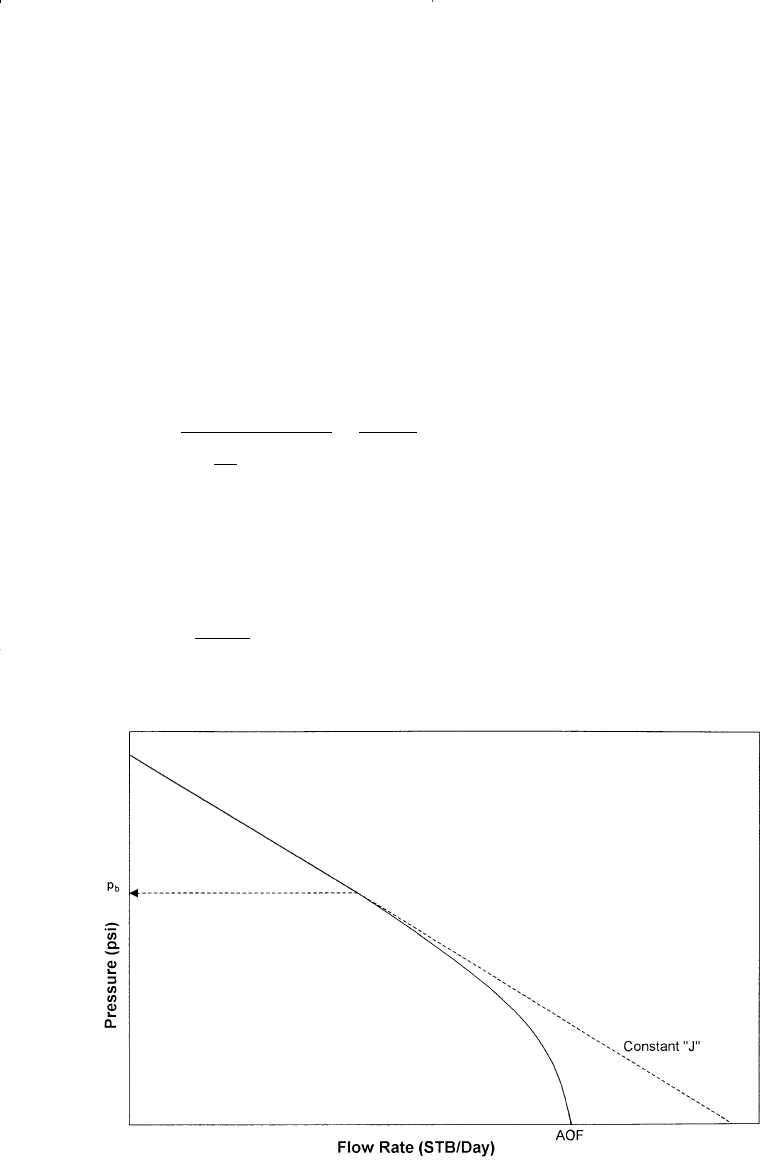
Equation 7-6 suggests that the inflow into a well is directly proportion-
al to the pressure drawdown and the constant of proportionality is the
productivity index. Muskat and Evinger (1942) and Vogel (1968)
observed that when the pressure drops below the bubble-point pressure,
the IPR deviates from that of the simple straight-line relationship as
shown in Figure 7-4.
Recalling Equation 7-4:
Treating the term between the two brackets as a constant c, the above
equation can be written in the following form:
Jc
k
B
ro
oo
=
Ê
Ë
Á
ˆ
¯
˜
m
(7 - 8)
J
hk
r
r
s
k
B
e
w
ro
oo
=
Ê
Ë
Á
ˆ
¯
˜
-+
È
Î
Í
Í
Í
Í
Í
˘
˚
˙
˙
˙
˙
˙
Ê
Ë
Á
ˆ
¯
˜
0 00708
075
.
ln .
m
Oil Well Performance 479
Figure 7-4. IPR below p
b
.
Reservoir Eng Hndbk Ch 07 2001-10-24 16:49 Page 479
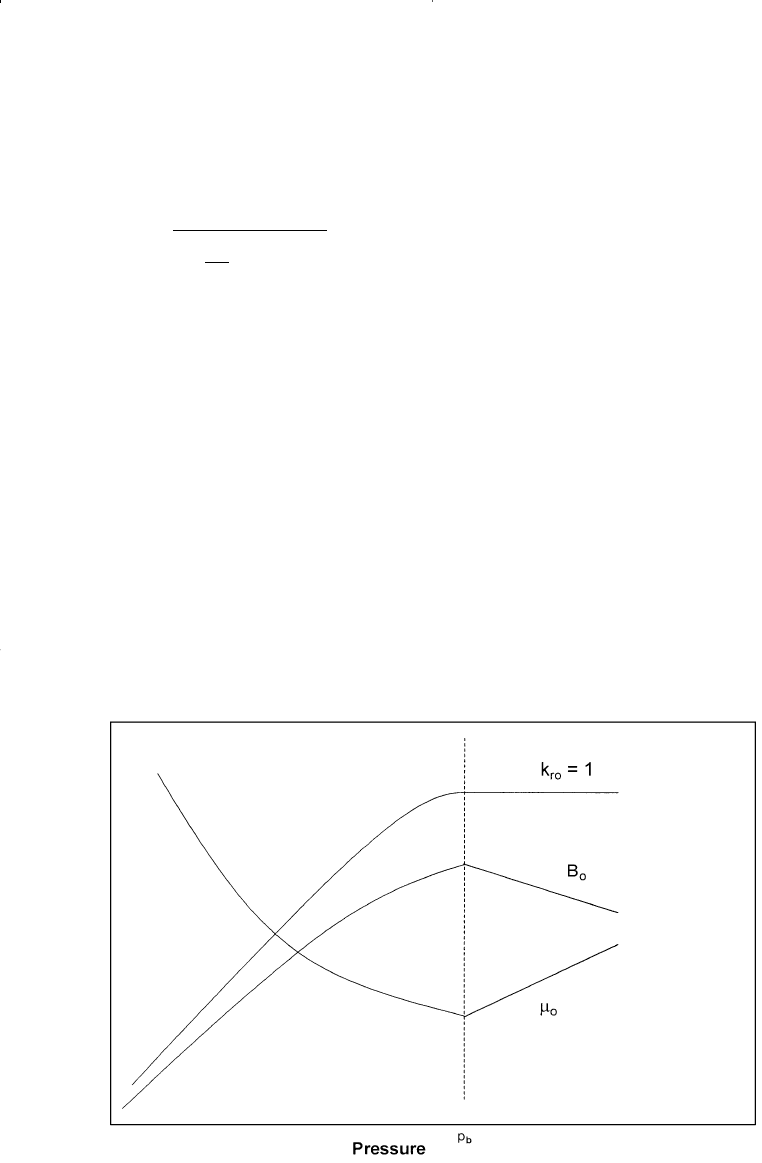
With the coefficient c as defined by:
Equation 7-8 reveals that the variables affecting the productivity index
are essentially those that are pressure dependent, i.e.:
• Oil viscosity m
o
• Oil formation volume factor B
o
• Relative permeability to oil k
ro
.
Figure 7-5 schematically illustrates the behavior of those variables as a
function of pressure. Figure 7-6 shows the overall effect of changing the
pressure on the term (k
ro
/m
o
b
o
). Above the bubble-point pressure p
b
, the
relative oil permeability k
ro
equals unity (k
ro
= 1) and the term (k
ro
/m
o
B
o
)
is almost constant. As the pressure declines below p
b
, the gas is released
c
kh
r
r
s
e
w
=
Ê
Ë
Á
ˆ
¯
˜
-+
0 00708
075
.
ln .
480 Reservoir Engineering Handbook
Figure 7-5. Effect of pressure on B
o
, m
o
, and k
ro
.
Reservoir Eng Hndbk Ch 07 2001-10-24 16:49 Page 480
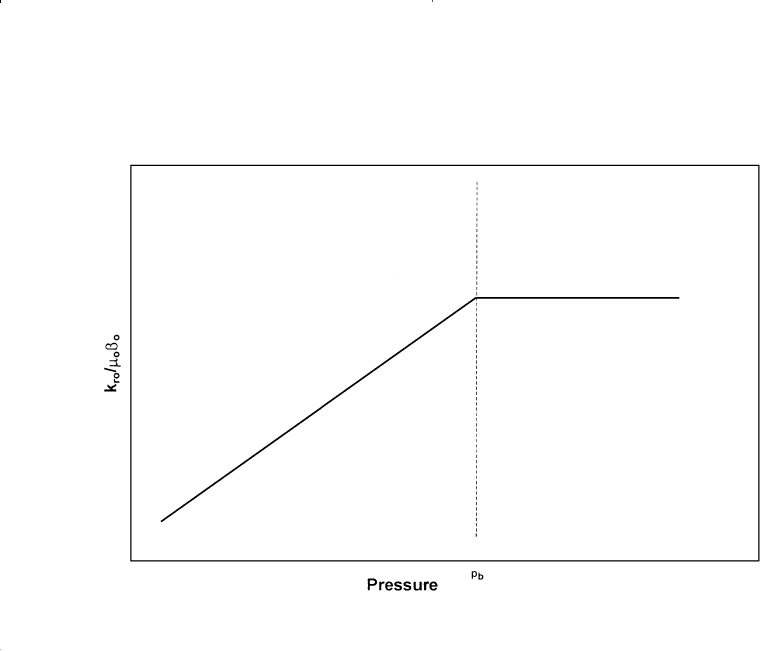
from solution which can cause a large decrease in both k
ro
and (k
ro
/m
o
B
o
).
Figure 7-7 shows qualitatively effect of reservoir depletion on the IPR.
There are several empirical methods that are designed to predict the
non-linearity behavior of the IPR for solution gas drive reservoirs. Most
of these methods require at least one stabilized flow test in which Q
o
and
p
wf
are measured. All the methods include the following two computa-
tional steps:
• Using the stabilized flow test data, construct the IPR curve at the cur-
rent average reservoir pressure p
–
r
.
• Predict future inflow performance relationships as to the function of
average reservoir pressures.
The following empirical methods that are designed to generate the cur-
rent and future inflow performance relationships:
• Vogel’s Method
• Wiggins’ Method
• Standing’s Method
• Fetkovich’s Method
• The Klins-Clark Method
Oil Well Performance 481
Figure 7-6. k
ro
/m
o
B
o
as a function of pressure.
Reservoir Eng Hndbk Ch 07 2001-10-24 16:49 Page 481
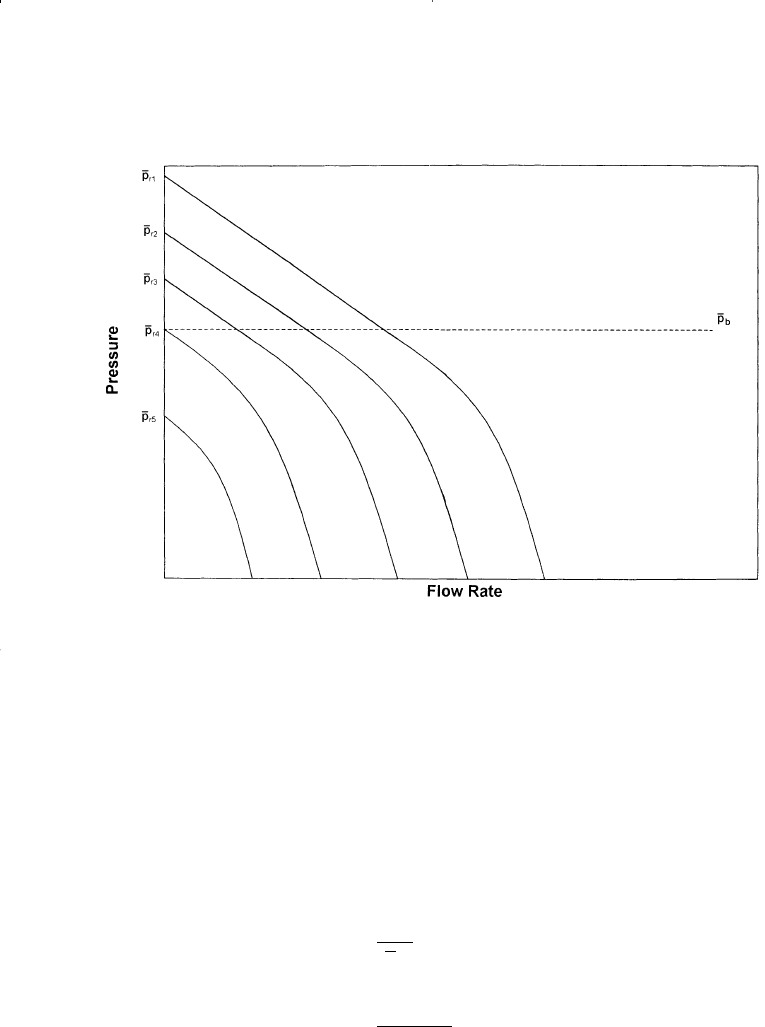
Vogel’s Method
Vogel (1968) used a computer model to generate IPRs for several
hypothetical saturated-oil reservoirs that are producing under a wide
range of conditions. Vogel normalized the calculated IPRs and expressed
the relationships in a dimensionless form. He normalized the IPRs by
introducing the following dimensionless parameters:
where (Q
o
)
max
is the flow rate at zero wellbore pressure, i.e., AOF.
dimensionless pressure =
Q
Q
o
o
()
max
dimensionless pressure =
p
p
wf
r
482 Reservoir Engineering Handbook
Figure 7-7. Effect of reservoir pressure on IPR.
Reservoir Eng Hndbk Ch 07 2001-10-24 16:49 Page 482
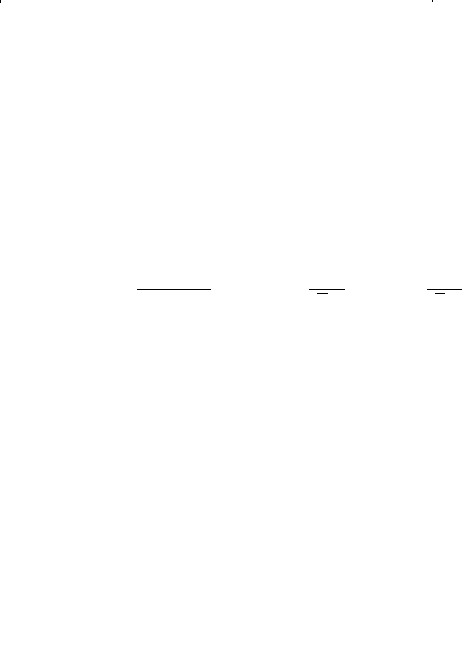
Vogel plotted the dimensionless IPR curves for all the reservoir cases
and arrived at the following relationship between the above dimension-
less parameters:
where Q
o
= oil rate at p
wf
(Q
o
)
max
= maximum oil flow rate at zero wellbore pressure, i.e., AOF
p
–
r
= current average reservoir pressure, psig
p
wf
= wellbore pressure, psig
Notice that p
wf
and p
–
r
must be expressed in psig.
Vogel’s method can be extended to account for water production by
replacing the dimensionless rate with Q
L
/(Q
L
)
max
where Q
L
= Q
o
+ Q
w
.
This has proved to be valid for wells producing at water cuts as high as
97%. The method requires the following data:
• Current average reservoir pressure p
–
r
• Bubble-point pressure p
b
• Stabilized flow test data that include Q
o
at p
wf
Vogel’s methodology can be used to predict the IPR curve for the fol-
lowing two types of reservoirs:
• Saturated oil reservoirs p
–
r
≤ p
b
• Undersaturated oil reservoirs p
–
r
> p
b
Saturated Oil Reservoirs
When the reservoir pressure equals the bubble-point pressure, the oil
reservoir is referred to as a saturated-oil reservoir. The computational
procedure of applying Vogel’s method in a saturated oil reservoir to gen-
erate the IPR curve for a well with a stabilized flow data point, i.e., a
recorded Q
o
value at p
wf
, is summarized below:
Q
Q
p
p
p
p
o
o
wf
r
wf
r
(
)
=-
Ê
Ë
Á
ˆ
¯
˜
-
Ê
Ë
Á
ˆ
¯
˜
max
..102 08
2
(7 - 9)
Oil Well Performance 483
Reservoir Eng Hndbk Ch 07 2001-10-24 16:49 Page 483
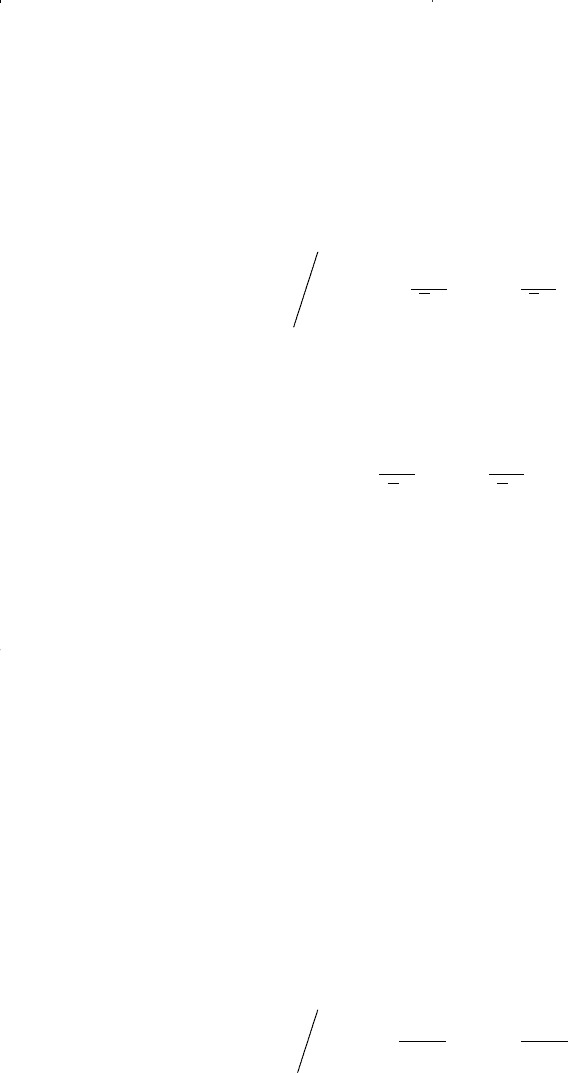
Step 1. Using the stabilized flow data, i.e., Q
o
and p
wf
, calculate:
(Q
o
)
max
from Equation 7-9, or
Step 2. Construct the IPR curve by assuming various values for p
wf
and
calculating the corresponding Q
o
from:
Example 7-2
A well is producing from a saturated reservoir with an average reser-
voir pressure of 2500 psig. Stabilized production test data indicated that
the stabilized rate and wellbore pressure are 350 STB/day and 2000 psig,
respectively. Calculate:
• Oil flow rate at p
wf
= 1850 psig
• Calculate oil flow rate assuming constant J
• Construct the IPR by using Vogel’s method and the constant productivi-
ty index approach.
Solution
Part A.
Step 1. Calculate (Q
o
)
max
:
() . .
./
max
Q
STB day
o
=-
Ê
Ë
ˆ
¯
-
Ê
Ë
ˆ
¯
È
Î
Í
˘
˚
˙
=
350 1 0 2
2000
2500
08
2000
2500
1067 1
2
QQ
p
p
p
p
oo
wf
r
wf
r
=-
Ê
Ë
Á
ˆ
¯
˜
-
Ê
Ë
Á
ˆ
¯
˜
È
Î
Í
Í
˘
˚
˙
˙
() . .
max
102 08
2
() . .
max
QQ
p
p
p
p
oo
wf
r
wf
r
=-
Ê
Ë
Á
ˆ
¯
˜
-
Ê
Ë
Á
ˆ
¯
˜
È
Î
Í
Í
˘
˚
˙
˙
102 08
2
484 Reservoir Engineering Handbook
Reservoir Eng Hndbk Ch 07 2001-10-24 16:49 Page 484

Step 2. Calculate Q
o
at p
wf
= 1850 psig by using Vogel’s equation
Part B.
Calculating oil flow rate by using the constant J approach
Step 1. Apply Equation 7-1 to determine J
Step 2. Calculate Q
o
Q
o
= J ( p
–
r
- p
wf
) = 0.7 (2500 - 1850) = 455 STB/day
Part C.
Generating the IPR by using the constant J approach and Vogel’s method:
Assume several values for p
wf
and calculate the corresponding Q
o
.
p
wf
Vogel’s Q
o
= J (p
–
r
- p
wf
)
2500 0 0
2200 218.2 210
1500 631.7 700
1000 845.1 1050
500 990.3 1400
0 1067.1 1750
Undersaturated Oil Reservoirs
Beggs (1991) pointed out that in applying Vogel’s method for under-
saturated reservoirs, there are two possible outcomes to the recorded
stabilized flow test data that must be considered, as shown schematical-
ly in Figure 7-8:
J STB day psi=
-
=
350
2500 2000
07.//
=-
Ê
Ë
ˆ
¯
-
Ê
Ë
ˆ
¯
È
Î
Í
˘
˚
˙
=1067 1 1 0 2
1850
2500
08
1850
2500
441 7
2
.. . ./STB day
QQ
p
p
p
p
oo
wf
r
wf
r
=
(
)
-
Ê
Ë
Á
ˆ
¯
˜
-
Ê
Ë
Á
ˆ
¯
˜
È
Î
Í
Í
˘
˚
˙
˙
max
..102 08
2
Oil Well Performance 485
Reservoir Eng Hndbk Ch 07 2001-10-24 16:49 Page 485
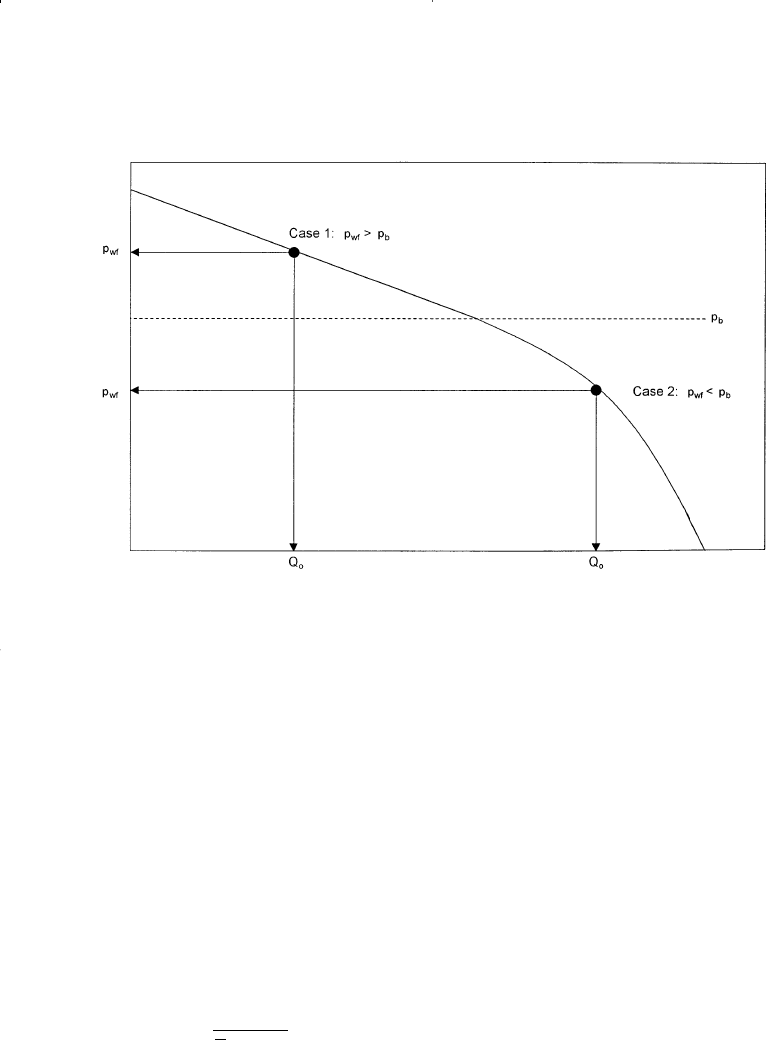
• The recorded stabilized bottom-hole flowing pressure is greater than or
equal to the bubble-point pressure, i.e. p
wf
≥ p
b
• The recorded stabilized bottom-hole flowing pressure is less than the
bubble-point pressure p
wf
< p
b
Case 1. The Value of the Recorded Stabilized p
wf
≥ p
b
Beggs outlined the following procedure for determining the IPR when
the stabilized bottom-hole pressure is greater than or equal to the bubble-
point pressure (Figure 7-8):
Step 1. Using the stabilized test data point (Q
o
and p
wf
) calculate the pro-
ductivity index J:
Step 2. Calculate the oil flow rate at the bubble-point pressure:
Q
ob
= J (p
–
r
- P
b
) (7-10)
where Q
ob
is the oil flow rate at p
b
J
Q
pp
o
rwf
=
-
486 Reservoir Engineering Handbook
Figure 7-8. Stabilized flow test data.
Reservoir Eng Hndbk Ch 07 2001-10-24 16:49 Page 486

Step 3. Generate the IPR values below the bubble-point pressure by
assuming different values of p
wf
< p
b
and calculating the corre-
spond oil flow rates by applying the following relationship:
The maximum oil flow rate (Q
o max
or AOF) occurs when the bottom-
hole flowing pressure is zero, i.e. p
wf
= 0, which can be determined from
the above expression as:
It should be pointed out that when p
wf
≥ p
b
, the IPR is linear and is
described by:
Q
o
= J (p
–
r
- p
wf
).
Example 7-3
An oil well is producing from an undersaturated reservoir that is char-
acterized by a bubble-point pressure of 2130 psig. The current average
reservoir pressure is 3000 psig. Available flow test data shows that the
well produced 250 STB/day at a stabilized p
wf
of 2500 psig. Construct
the IPR data.
Solution
The problem indicates that the flow test data was recorded above the
bubble-point pressure, therefore, the Case 1 procedure for undersaturated
reservoirs as outlined previously must be used.
Step 1. Calculate J using the flow test data.
Step 2. Calculate the oil flow rate at the bubble-point pressure by apply-
ing Equation 7-10.
Q
ob
= 0.5 (3000 - 2130) = 435 STB/day
J STB day psi=
-
=
250
3000 2500
05.//
QQ
Jp
oob
b
max
.
=+
18
QQ
Jp p
p
p
p
oob
bwf
b
wf
b
=+ -
Ê
Ë
Á
ˆ
¯
˜
-
Ê
Ë
Á
ˆ
¯
˜
È
Î
Í
Í
˘
˚
˙
˙
18
102 08
2
.
. . (7 -11)
Oil Well Performance 487
Reservoir Eng Hndbk Ch 07 2001-10-24 16:49 Page 487
